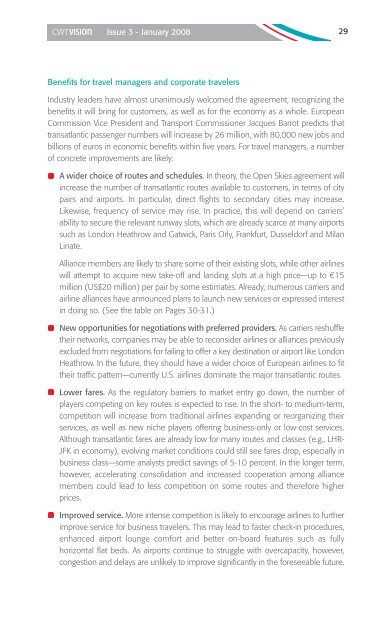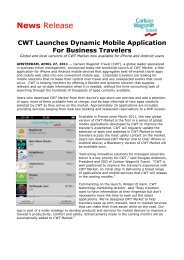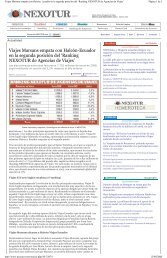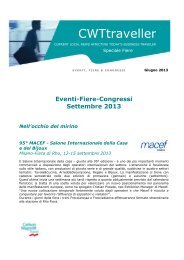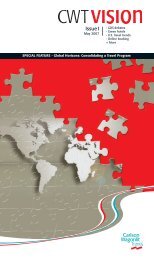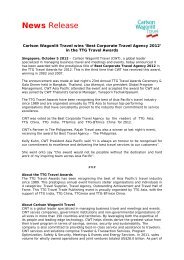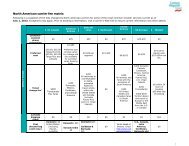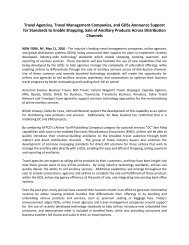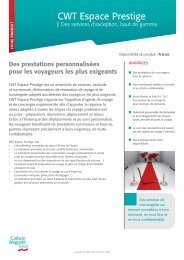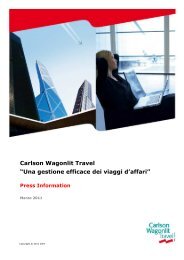Getting With the Program - Carlson Wagonlit Travel
Getting With the Program - Carlson Wagonlit Travel
Getting With the Program - Carlson Wagonlit Travel
You also want an ePaper? Increase the reach of your titles
YUMPU automatically turns print PDFs into web optimized ePapers that Google loves.
CWTvIsIon Issue 3 - January 20082Benefits for travel managers and corporate travelersIndustry leaders have almost unanimously welcomed <strong>the</strong> agreement, recognizing <strong>the</strong>benefits it will bring for customers, as well as for <strong>the</strong> economy as a whole. EuropeanCommission Vice President and Transport Commissioner Jacques Barrot predicts thattransatlantic passenger numbers will increase by 26 million, with 80,000 new jobs andbillions of euros in economic benefits within five years. For travel managers, a numberof concrete improvements are likely:A wider choice of routes and schedules. In <strong>the</strong>ory, <strong>the</strong> Open Skies agreement willincrease <strong>the</strong> number of transatlantic routes available to customers, in terms of citypairs and airports. In particular, direct flights to secondary cities may increase.Likewise, frequency of service may rise. In practice, this will depend on carriers’ability to secure <strong>the</strong> relevant runway slots, which are already scarce at many airportssuch as London Heathrow and Gatwick, Paris Orly, Frankfurt, Dusseldorf and MilanLinate.Alliance members are likely to share some of <strong>the</strong>ir existing slots, while o<strong>the</strong>r airlineswill attempt to acquire new take-off and landing slots at a high price—up to €15million (US$20 million) per pair by some estimates. Already, numerous carriers andairline alliances have announced plans to launch new services or expressed interestin doing so. (See <strong>the</strong> table on Pages 30-31.)New opportunities for negotiations with preferred providers. As carriers reshuffle<strong>the</strong>ir networks, companies may be able to reconsider airlines or alliances previouslyexcluded from negotiations for failing to offer a key destination or airport like LondonHeathrow. In <strong>the</strong> future, <strong>the</strong>y should have a wider choice of European airlines to fit<strong>the</strong>ir traffic pattern—currently U.S. airlines dominate <strong>the</strong> major transatlantic routes.Lower fares. As <strong>the</strong> regulatory barriers to market entry go down, <strong>the</strong> number ofplayers competing on key routes is expected to rise. In <strong>the</strong> short- to medium-term,competition will increase from traditional airlines expanding or reorganizing <strong>the</strong>irservices, as well as new niche players offering business-only or low-cost services.Although transatlantic fares are already low for many routes and classes (e.g., LHR-JFK in economy), evolving market conditions could still see fares drop, especially inbusiness class—some analysts predict savings of 5-10 percent. In <strong>the</strong> longer term,however, accelerating consolidation and increased cooperation among alliancemembers could lead to less competition on some routes and <strong>the</strong>refore higherprices.Improved service. More intense competition is likely to encourage airlines to fur<strong>the</strong>rimprove service for business travelers. This may lead to faster check-in procedures,enhanced airport lounge comfort and better on-board features such as fullyhorizontal flat beds. As airports continue to struggle with overcapacity, however,congestion and delays are unlikely to improve significantly in <strong>the</strong> foreseeable future.


